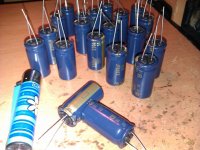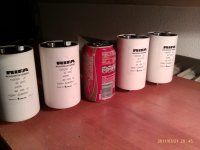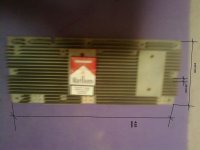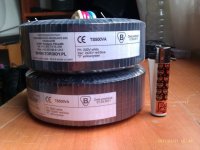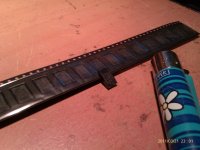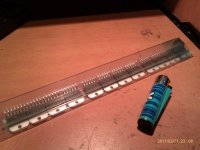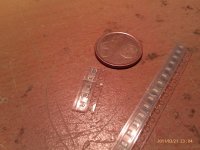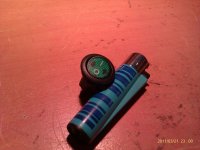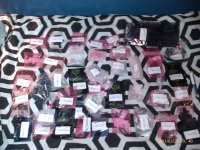But sorry for not answering properly; the BPA300 will be used with a preamp I diy-ed. It is a OPA627 with a BUF634 on its feedback loop, that way I can use it with almost any headphone too. I placed 50ohm in series with the line out, to mitigate capacitante effects of long cabling.
The LM3886 is a fabulous invention. It has been used in many applications where it probably should not have been used and succeeded flawlessly. We must at first consider that this is a monolithic device on a rather limited footprint. There are a plethora of circuits in this small device ie, preamp, output section and staibizing circuits all which must be cooled by the external dimensions.
If this chip is properly implemented it will surpass many a discrete design. We must not try to incorporate it into amp layout where it was not ment to go.
DIY types like us will always be pushing the envelope to achieve more performance from an item than the design engineers ever expected.
I like the Jeff Rowland clone layout and with adequate heatsinks and frugal expectations this BPA 300 amp will surpass many properly designed discrete amps.
Using a well designed an robust power supply with limited DC voltage into a sane load any DIY can have a world class amp at very affordable monetary outlay of currency.
I must again applaud Alexw for his gift to this community. Without the many hours of study and trial and error we would not be building this nice amp.
Now if we want a truly superior amp driving difficult and insane loads the Marshall Leach amp can not be beaten.
I would couple the BPA to a nice high treble speaker system and bi-amp with a discrete unit in the middle and lower end.
Tad
If this chip is properly implemented it will surpass many a discrete design. We must not try to incorporate it into amp layout where it was not ment to go.
DIY types like us will always be pushing the envelope to achieve more performance from an item than the design engineers ever expected.
I like the Jeff Rowland clone layout and with adequate heatsinks and frugal expectations this BPA 300 amp will surpass many properly designed discrete amps.
Using a well designed an robust power supply with limited DC voltage into a sane load any DIY can have a world class amp at very affordable monetary outlay of currency.
I must again applaud Alexw for his gift to this community. Without the many hours of study and trial and error we would not be building this nice amp.
Now if we want a truly superior amp driving difficult and insane loads the Marshall Leach amp can not be beaten.
I would couple the BPA to a nice high treble speaker system and bi-amp with a discrete unit in the middle and lower end.
Tad
Hey Tad,
Here' s an outline of my project that is similar to your suggestions. The first photo is a set-up rig to test and compare the BPA150 to the MyRef.

This is the proposed layout of the two amp types combined on one level. All the transformers will be encased below, either by themselves or with the BPA power boards also on that level. I'm taking this approach to simplify outboard cabling between amps and Xover - keeping amp/s ins and outs on one level..
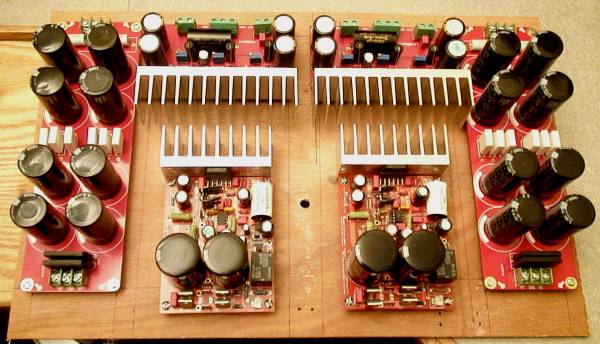
The sandwich is completed with a dbx 234 crossover on the bottom (to allow BPA/MyRef heat sink ventilation) on the lowest level. The active crossover has a "Low Sum" mode that can be used to drive a single Hefler DH-120/Sub for a full three way configuration.

Initially, this whole system is attended to be used in a rack mount (the layout board is the standard 17" W for racks) home studio setting and not for a "living room" audiophile approach - but who knows - I'll see what sounds best after testing and comparisons.
Suggestions Welcomed!
Here' s an outline of my project that is similar to your suggestions. The first photo is a set-up rig to test and compare the BPA150 to the MyRef.

This is the proposed layout of the two amp types combined on one level. All the transformers will be encased below, either by themselves or with the BPA power boards also on that level. I'm taking this approach to simplify outboard cabling between amps and Xover - keeping amp/s ins and outs on one level..

The sandwich is completed with a dbx 234 crossover on the bottom (to allow BPA/MyRef heat sink ventilation) on the lowest level. The active crossover has a "Low Sum" mode that can be used to drive a single Hefler DH-120/Sub for a full three way configuration.

Initially, this whole system is attended to be used in a rack mount (the layout board is the standard 17" W for racks) home studio setting and not for a "living room" audiophile approach - but who knows - I'll see what sounds best after testing and comparisons.
Suggestions Welcomed!
Last edited:
bcmbob, Where did you get the power supply pcb's. They make for a nice clean professional layout. Are you going to keep the heatsinks inside the cabinet or have the fins exposed to the outside? I think a small fan would be very beneficial here.
Have any of you gone to the diy forum site BPA300 built and measured by Alex. He also has a website with a plethora of good stuff. I think it is shine7.com or something close. He has done a great deal of work with this board including the transformer splitting input signal and some other really cool stuff.
The original Jeff Rowland Consort10 or whatever got really good press with this setup. The interior of the amp is awesome to say the least. I think the pcb's are 3d. At least they look that way from the photos. One real class act. Alex has some good shots on his website.
There are also some good builds utilizing the LME frontend chips which gives you the choice of monolithic frontend and discrete output section. These also have fabulous specs. You can use the same power supply and experiment.
For me now I am going retro with tubes and all. I want to see what all of the hoopala is all about. I love working with 850 volt circuits. Kind of like parachuting but never leaving the ground.
Remember what your friends see is the chassis and cabinet. Spare no expense or time making it looooook GOOOOOd.
Tad
Have any of you gone to the diy forum site BPA300 built and measured by Alex. He also has a website with a plethora of good stuff. I think it is shine7.com or something close. He has done a great deal of work with this board including the transformer splitting input signal and some other really cool stuff.
The original Jeff Rowland Consort10 or whatever got really good press with this setup. The interior of the amp is awesome to say the least. I think the pcb's are 3d. At least they look that way from the photos. One real class act. Alex has some good shots on his website.
There are also some good builds utilizing the LME frontend chips which gives you the choice of monolithic frontend and discrete output section. These also have fabulous specs. You can use the same power supply and experiment.
For me now I am going retro with tubes and all. I want to see what all of the hoopala is all about. I love working with 850 volt circuits. Kind of like parachuting but never leaving the ground.
Remember what your friends see is the chassis and cabinet. Spare no expense or time making it looooook GOOOOOd.
Tad
I should have known!!
Early but clear verdict.
I set up the BPA-150 rig on the big three-way Sunflowers with my modded PS1 as a source playing through the Lightspeed attenuator. The sound again was clear, extremely well defined and balanced.
On Spyro Gyra "Road Scholars" track 2, I thought I had a problem when I heard a muffled static, and was about to pull the plug when I realized it was the background singers clapping. I've played that CD forever and never heard that (or noticed it) in over six years.
Next I played Nancy Wilson's "If I Had My Way". This CD is very tricky - meaning if a system has any tenancy to produce syllabance (that super sssse distortion) this album will bring it out in spades. The BPA was as clean and free of this type of distortion as anything I have owned. I'm getting excited now!
The third piece was the Vienna Philharmonic playing "The Ride of the Wolkure" on a London Digital Disk. Everything was balanced from top to bottom and again, the stage presentation reminded me a lot of what one hears with headphones. Very precise and deep with no hint of horizontal pitch-dependent shift
.
At this point it dawned on me that with three LM3886s working (six actually), I wasn't getting a higher SPL. I have always twirled the LDR attenuators close to max so it was time to introduce some gain. I replaced the Lightspeed with a Carver C-1, using Aux 1 input and all tone control switched out of circuit. Got all the volume I could ask for and still almost as clean as the LDR attenuator. The slope of the volume knob on the Carver is, by design, gradual up to about 12:00 and thereafter much more active. Set at 2:00 gave me just under "loud" - what I interpret as an "in the band" experience. I was listening to a very accurate, balanced and well defined system.
To do the first MyRef comparison, I just turned everything off without touching any knobs and switched in the V1.3 amp. Wanna guess??
The piece was "Rob McConnell & the Boss Brass".
The MyRef-C “BLEW ME AWAY” I was instantly transported into the recording studio – No Bull !!
Not too much of an exaggeration, but the sound of the stick on the cymbal was there but I could also see what color shirt the drummer was wearing. That description is really quite accurate. I heard the difference between listening to an excellent system compared to having the impression of being in the room with the musicians. I am continually and absolutely amazed at what the MyRef-C is capable of. So the comparison results are – there is no comparison. The MyRef ,IMHO, is in a league far above the majority of amps I’ve heard – both DIY and many “Audio Boutique” offerings.
That description is really quite accurate. I heard the difference between listening to an excellent system compared to having the impression of being in the room with the musicians. I am continually and absolutely amazed at what the MyRef-C is capable of. So the comparison results are – there is no comparison. The MyRef ,IMHO, is in a league far above the majority of amps I’ve heard – both DIY and many “Audio Boutique” offerings.
I still intend to complete the bi-amp/tri-amp studio build but that is a completely different animal. The BPA-150 will be a good fit for the mid frequencies in that system.
Be sure to understand that I feel anyone who sticks with the BPA approach will be more than pleased with the results. For a bedroom or small home studio, the BPA is an excellent choice. This is - after all - the BPA thread and I have no regrets, and learned one heck of a lot building these amps. The ability to push a variety of loads is a real plus for the multiple LM3886 design and I would not hesitate to use in again. I'll post when the studio build is complete.
Regards,
Early but clear verdict.
I set up the BPA-150 rig on the big three-way Sunflowers with my modded PS1 as a source playing through the Lightspeed attenuator. The sound again was clear, extremely well defined and balanced.
On Spyro Gyra "Road Scholars" track 2, I thought I had a problem when I heard a muffled static, and was about to pull the plug when I realized it was the background singers clapping. I've played that CD forever and never heard that (or noticed it) in over six years.
Next I played Nancy Wilson's "If I Had My Way". This CD is very tricky - meaning if a system has any tenancy to produce syllabance (that super sssse distortion) this album will bring it out in spades. The BPA was as clean and free of this type of distortion as anything I have owned. I'm getting excited now!
The third piece was the Vienna Philharmonic playing "The Ride of the Wolkure" on a London Digital Disk. Everything was balanced from top to bottom and again, the stage presentation reminded me a lot of what one hears with headphones. Very precise and deep with no hint of horizontal pitch-dependent shift
.
At this point it dawned on me that with three LM3886s working (six actually), I wasn't getting a higher SPL. I have always twirled the LDR attenuators close to max so it was time to introduce some gain. I replaced the Lightspeed with a Carver C-1, using Aux 1 input and all tone control switched out of circuit. Got all the volume I could ask for and still almost as clean as the LDR attenuator. The slope of the volume knob on the Carver is, by design, gradual up to about 12:00 and thereafter much more active. Set at 2:00 gave me just under "loud" - what I interpret as an "in the band" experience. I was listening to a very accurate, balanced and well defined system.
To do the first MyRef comparison, I just turned everything off without touching any knobs and switched in the V1.3 amp. Wanna guess??
The piece was "Rob McConnell & the Boss Brass".
The MyRef-C “BLEW ME AWAY” I was instantly transported into the recording studio – No Bull !!
Not too much of an exaggeration, but the sound of the stick on the cymbal was there but I could also see what color shirt the drummer was wearing.
I still intend to complete the bi-amp/tri-amp studio build but that is a completely different animal. The BPA-150 will be a good fit for the mid frequencies in that system.
Be sure to understand that I feel anyone who sticks with the BPA approach will be more than pleased with the results. For a bedroom or small home studio, the BPA is an excellent choice. This is - after all - the BPA thread and I have no regrets, and learned one heck of a lot building these amps. The ability to push a variety of loads is a real plus for the multiple LM3886 design and I would not hesitate to use in again. I'll post when the studio build is complete.
Regards,
Last edited:
Hey Tad,
Both the boards came from the same place on eBay. Check back at post 1130 in this thread for direct links.
For the heat sinks, I bought two 10"x3"x1.25" pieces from Heatsinks USA and cut one down to fit the test build. The single aluminum plate in the earlier pictures took all six LM3886 chips and never went above 110F/38C, so my first design was over built. The final case will have openings below and above the heat sinks. You probably didn't notice but there is a quarter inch gap between the bottom of the heat sink and the mounting plate that will help with air flow. I might mount them external if there is a heat problem.
I also read all the stuff at Shine 7 and that's how I got interested in the BPA design. That is indeed a good site. I originally expected much more immediate power with the 150 rating but learned subsequently that the higher number has more to do with driving different loads and not so much raw power. Still an excellent amp design.
Both the boards came from the same place on eBay. Check back at post 1130 in this thread for direct links.
For the heat sinks, I bought two 10"x3"x1.25" pieces from Heatsinks USA and cut one down to fit the test build. The single aluminum plate in the earlier pictures took all six LM3886 chips and never went above 110F/38C, so my first design was over built. The final case will have openings below and above the heat sinks. You probably didn't notice but there is a quarter inch gap between the bottom of the heat sink and the mounting plate that will help with air flow. I might mount them external if there is a heat problem.
I also read all the stuff at Shine 7 and that's how I got interested in the BPA design. That is indeed a good site. I originally expected much more immediate power with the 150 rating but learned subsequently that the higher number has more to do with driving different loads and not so much raw power. Still an excellent amp design.
It is a really nice feeling when you spend so much time hunting down just the right set of parts and getting everything soldered into those small SMD spaces hook up the juice and it works. I never get tired of a job without smoke.
It is rare that I come across someone at work or anywhere around here who has a true productive hobby. Aside from shooting poor defenseless animals and watching the reruns of the Beverly Hillbillies most of the crowd around here has no hobbies at all. Just spend all of your money on Friday night and listen to music in the car.
I only wish I could have started this many decades ago when my learning abilities were somewhat more acute.
I shall see if I can find those pcb's and I will wait for the chassis and cabinet design to be posted. Truly nice job.
Tad
It is rare that I come across someone at work or anywhere around here who has a true productive hobby. Aside from shooting poor defenseless animals and watching the reruns of the Beverly Hillbillies most of the crowd around here has no hobbies at all. Just spend all of your money on Friday night and listen to music in the car.
I only wish I could have started this many decades ago when my learning abilities were somewhat more acute.
I shall see if I can find those pcb's and I will wait for the chassis and cabinet design to be posted. Truly nice job.
Tad
Could you provide us with some examples? I remember to have seen something but, what would you recommend?There are also some good builds utilizing the LME frontend chips which gives you the choice of monolithic frontend and discrete output section. These also have fabulous specs. You can use the same power supply and experiment.
I can only recommend what you might be comfortable with budget and skills wise. Panson (google pansonaudio) has some nice inexpensive boards which he designed that will get you going in the right direction utilizing the LME498xx series from National. The major advantage, in my opinion, to the LME series over the monolithic 3886 is footprint space for heat transfer. Using 4 mosfet or bjt output transistors to construct your project from the LME frontend will give you a much cooler running amp -- this being my experience.
The LM3886 has to cool the entire frontend and output section on it's small die. The LMExx series also offers Class A operation in one of it's offerings.
I just got back upstairs after sorting through my plethora of stuff. Rehashing this thread has gotten me in the mood to finish some of these projects. The weather has also made a nice contribution. I need to start winding up some plus/minus balancing transformers to split up my single end signal.
If my memory serves me correctly I sent out several hundred of these BPA pcb's for a gentlemen in England who ran into some trouble. Peranders took over from there and many folks got to finish there builds. Time sure goes by fast.
One more reminder. Alexw88 who did such a splendid job with this layout chose to power his amps with approximately 25 finished D.C. volts. The published material states that higher voltage is usable, however, this is a bridge/parallel design. Mucho more heat to deal with.
If enough interest is out there we could have a few hundred boards made up and distribute them around the globe as before. I do not know if there is a current supply of these boards available at the present. They are not expensive to have made and the parts are few and inexpensive. A very nice project to get into chipamps with. The Jeff Rowland model 10 cost 6500 dollars. I checked this out last night. The BPA300 is a close exact copy electronically speaking. The chassis is another thing altogether.
Tad
The LM3886 has to cool the entire frontend and output section on it's small die. The LMExx series also offers Class A operation in one of it's offerings.
I just got back upstairs after sorting through my plethora of stuff. Rehashing this thread has gotten me in the mood to finish some of these projects. The weather has also made a nice contribution. I need to start winding up some plus/minus balancing transformers to split up my single end signal.
If my memory serves me correctly I sent out several hundred of these BPA pcb's for a gentlemen in England who ran into some trouble. Peranders took over from there and many folks got to finish there builds. Time sure goes by fast.
One more reminder. Alexw88 who did such a splendid job with this layout chose to power his amps with approximately 25 finished D.C. volts. The published material states that higher voltage is usable, however, this is a bridge/parallel design. Mucho more heat to deal with.
If enough interest is out there we could have a few hundred boards made up and distribute them around the globe as before. I do not know if there is a current supply of these boards available at the present. They are not expensive to have made and the parts are few and inexpensive. A very nice project to get into chipamps with. The Jeff Rowland model 10 cost 6500 dollars. I checked this out last night. The BPA300 is a close exact copy electronically speaking. The chassis is another thing altogether.
Tad
Well, i will show you some progress I've made around my BPA-300 construction. It's being made for a friend, as a no-mind-cost proyect, so everything is quite overspecified. It's encased as two monoblocks inside the same enclosure.
Attached are some pictures of the materials,
2x 500VA 2x25vac ordered from toroidy.pl
4x 100.000uF 40v RIFA PEH200
16x 2.200uF 50v Panasonic FC
Hefty refurbished big heatsinks (from military equipment)
Other received stuff...
Attached are some pictures of the materials,
2x 500VA 2x25vac ordered from toroidy.pl
4x 100.000uF 40v RIFA PEH200
16x 2.200uF 50v Panasonic FC
Hefty refurbished big heatsinks (from military equipment)
Other received stuff...
Attachments
Hey tryonziess,
You got me thinking about the heat sinks so I went a little nuts yesterday. I think this will give both enough mass and air flow for all eight chips. The plate (10.25" x 3") and the thickest part of the modular pieces are .25" thick. I thought about mounting with fins up (as they should be) but it added too much height.
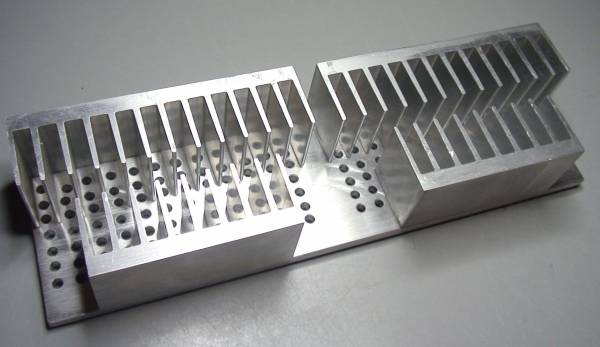

Will try to surface grind mating surfaces but I have some good thermal transfer tape as a backup.
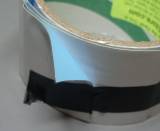
The HS will be mounted on posts but there is enough room to place a thin fan above or below if needed. I think top and bottom case vents will probably work.
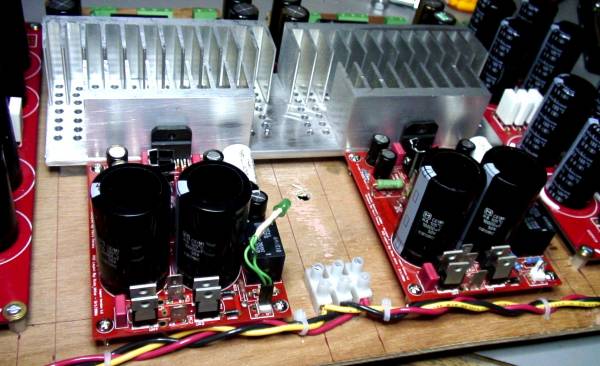
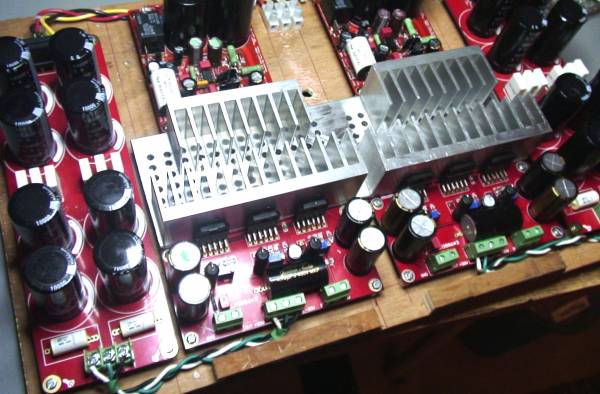
With the BPA-150 tests completed, I've removed the in and out sockets to be rebuilt to match those on the dbx crossover. The board is 17" x 11" and eventually will be a metal mounting surface.
You got me thinking about the heat sinks so I went a little nuts yesterday. I think this will give both enough mass and air flow for all eight chips. The plate (10.25" x 3") and the thickest part of the modular pieces are .25" thick. I thought about mounting with fins up (as they should be) but it added too much height.
Will try to surface grind mating surfaces but I have some good thermal transfer tape as a backup.
The HS will be mounted on posts but there is enough room to place a thin fan above or below if needed. I think top and bottom case vents will probably work.
With the BPA-150 tests completed, I've removed the in and out sockets to be rebuilt to match those on the dbx crossover. The board is 17" x 11" and eventually will be a metal mounting surface.
Where did you get those nice Rifa capacitors. I have always considered them to be at the top of the pile. They pack a serious charge. Mind me asking how much you had to pay.
I found that placing a nice thick piece of copper or aluminum on the top of the Lm3886 as they did in the Jeff Rowland helps smooth out the heat transfer. Also, one long strip of Kapton tape will cover all three chips fold up and insulate the top if you use the header pieceA of metal.
What is the board with the four rectifiers for. It has a large transistor at the back against the heatsink? Did you also, mount the film caps on the legs of the LM3886 chips for stability as recommended in the literature. Important.
What you going to use for the volume control? Let us not skimp here you are doing a good job.
Ain't this stuff fun. And it does not pollute at all. It is also legal.
Tad
I found that placing a nice thick piece of copper or aluminum on the top of the Lm3886 as they did in the Jeff Rowland helps smooth out the heat transfer. Also, one long strip of Kapton tape will cover all three chips fold up and insulate the top if you use the header pieceA of metal.
What is the board with the four rectifiers for. It has a large transistor at the back against the heatsink? Did you also, mount the film caps on the legs of the LM3886 chips for stability as recommended in the literature. Important.
What you going to use for the volume control? Let us not skimp here you are doing a good job.
Ain't this stuff fun. And it does not pollute at all. It is also legal.
Tad
- Status
- This old topic is closed. If you want to reopen this topic, contact a moderator using the "Report Post" button.
- Home
- Group Buys
- BPA300 Round 2
